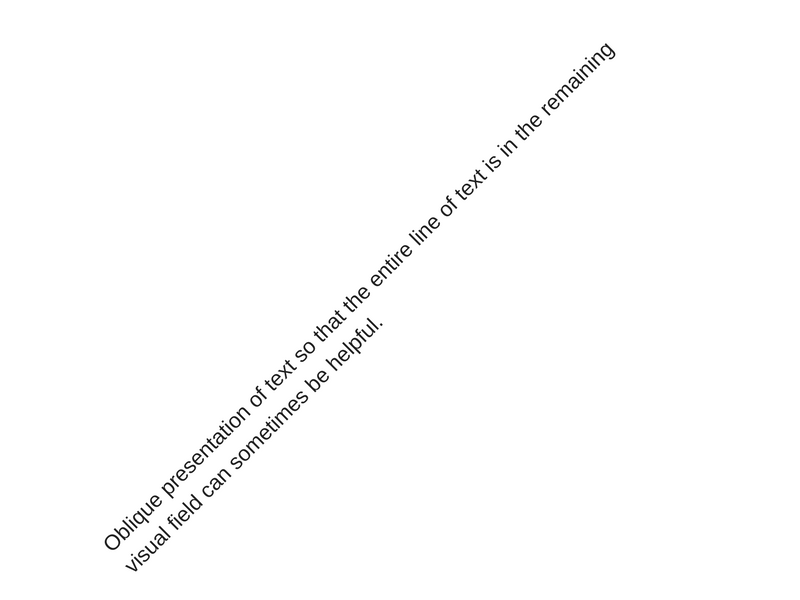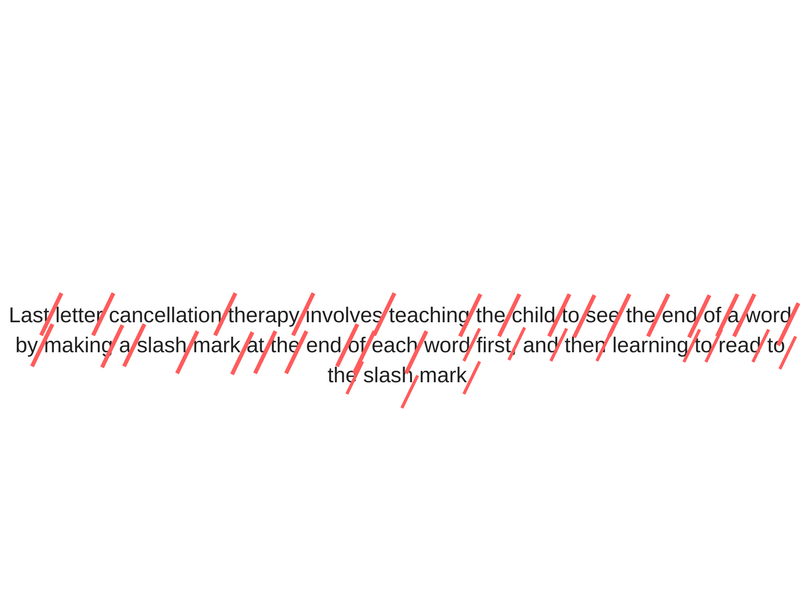The child should learn as early as possible to advocate for themselves. This should be part of the Individual Education Plan (IEP). The educational staff should allow the child to say what he/she cannot see, in what position in the class they see best, or if they do not feel safe. Self-advocacy is one of the most important social, emotional, and educational skills we can teach.
Because we understand how adults with hemianopic reading impairment (sometimes referred to as hemianopic dyslexia) relearn reading skills after brain injury or stroke, these same interventions may be helpful for children with homonymous hemianopia who are learning how to read. They include:
- Oblique presentation Rotating the page 45-90 degrees, so that the entire line of text is in the remaining visual field, can be helpful for some children. Research shows that it is most helpful for right hemianopia.

- Wood stick method This method has the child use a long wooden stick on a chalkboard or whiteboard which they move from word to word as they read off a board. Children with left-sided hemianopia (which results after right-sided surgeries) are asked to tap the wooden stick on the beginning of the next word. Children with right-sided hemianopia (which results after left-sided surgeries) are asked to tap the wooden stick on the end of the next word. This teaches the child to shift their gaze intentionally (known as attentional gaze shift) into the blind field. In adults who have hemianopic visual loss, this method showed improved reading after a few weeks.
- Long gaze shift method This method requires the reader to scan all the way to the end of the line first so they understand how many words are in the line as well as the length of each word. This requires the child to perceive each word as a whole first before reading it.
- Electronic reading aids with gliding text Electronic reading aids magnify text from a book or magazine onto a computer screen. This allows the reader to view the words in larger print against a bright background which improves oculomotor control. Examples of electronic reading aids include:
- Boundary marking devices Boundary marking devices, such as translucent plastic with a bright red boundary line, can help the child scan to the next line of text.
- Last letter cancellation therapy Similar to the wood stick method above, this strategy requires the child with right hemianopia to first mark the last letter of a word before reading it. This trains the child to scan to the end of a word before reading it.

- Next line/first part of word therapy Similar to last line cancellation therapy, this method is for right-sided surgeries which result in left hemianopia. These children show difficulties locating the next line of text. This method teaches the child to scan to the subsequent line of text as well as to see the first part of the word.
- Seeing the whole word Provide the child with strategies so that the child sees the entire word and is trained to look at the middle/root of the word.
In school, accommodations should be provided to ensure that all instructional material remain within the child’s field of vision. For example, they can include the following:
- When appropriate, small text ensures that more of a word is in the remaining visual field.
- Vertical presentation can be beneficial so that material is not missed. Columns of text may be easier to read than whole pages of uncolumned text. Present visual materials on a slanted surface for viewing. A computer screen is ideal as the surface is vertical. The position of the child’s face relative to the slanted surface or screen is important. The surface should be biased toward the child’s seeing field (leftward in the case of right field loss, and rightward in the case of a left field loss.)
- Oblique presentation of lines of text (such as when turning the page 45 -90 degrees) and allowing the child to tilt his/her head to see the whole line of text better. These adjustments should be understood as a helpful and functional adaptations by the child;
- Teach the child to systematically scan visual materials during any task which requires vision. Scanning a page of images should be taught from the left to right and top to bottom. This will help set a habit for reading languages that are read from left to right, like English or Spanish;
- When reading a line of text, help the child understand the sequence of words by moving your finger underneath each word. Also, a ruler can be placed underneath the line of text to guide the eye. Reading guide highlighter strips are simple devices which form a window that masks the lines above and below the line of text and can be slid along the line while reading so that the child sees only the line of text being read;
- For a child with left hemianopia, the problem in reading involves returning from the right end of a line to the left and down to the next line. This can be difficult especially for the beginning reader. Using your finger to follow back along the line that was read, and down to the next line may be helpful. To guide the eyes to the left and down, a ruler placed along the left edge of the text or an L-shaped guide shifted down to the next line can be used. Color coding of left and right margins may be helpful;
- Make the child aware of the whole array of objects and both pages in a book. Ask him/her to point out different things on the page and make them aware of both pages, starting from the left;
- Children with hemianopia may forget to write or draw on the part of the paper that falls into their lost field. Compensatory strategies like oblique presentation with head tilt may be helpful;
- A slanted surface for writing may be helpful;
- A bold dark felt tip pen may provide better writing and drawing than a pencil. This increases contrast between the letters and papers when learning to write. Lined paper can also be helpful for writing as well as graph paper for math;
- Make sure the child is aware of the entire piece of lined paper before writing;
- Seating in the classroom should be where the child’s remaining visual field can take in what the teacher presents to the class as a whole. This may be in the back of the classroom for some activities, or in the front for others. When facing the front of the classroom and the teacher, the child with a right field loss should be seated to the RIGHT facing the front, with the teacher on the child’s LEFT. And the child with a left field loss should be seated to the LEFT facing front with the teacher on the child’s RIGHT. In a semicircular group, placement of the child with a visual field loss should be guided by the activities and where the child’s attention should be directed. If the goal is to attend to the teacher, then the teacher should be well in the child’s seeing field. If the goal is to interact with the other children, then the child with a field defect should be positioned so that as many of the other children as possible are in the seeing field. Positioning in the classroom needs continuous reevaluation by the educational staff. If the child can advocate for themselves, they can vocalize where the best position for their access to information is.
- Independence and safety are important for the child and require continuous reevaluation;
- Provide additional lighting so that the child can see things clearly;
- Children with field loss may have difficulty locating objects and people at distance, even if their distance visual acuity is normal. The child should be taught to scan objects at various distances and accommodations must be designed and implemented across all activities and environments;
- The child’s classroom, hallways, stairways, and playground should be evaluated for potential hazards often;
- Mark crucial features such as stairs and railings for better visibility as needed. Furniture and other objects should be located in the same place every day so as not to confuse the child. Introduce safety features such as Exit signs early and often.
Next – Compensatory strategies
 SUBSCRIBE TO OUR MAILING LIST
SUBSCRIBE TO OUR MAILING LIST